La Semana Ultima En Peru

Monday greeted me with an early morning flight back to Lima, where I had a total of five minutes to get ready at the house before heading off to school.
Where last week had been quiet and calm with only four students at the school, this week has filled with new faces and lots of loud commotion. I met students from Switzerland, Germany, Brazil and the U.S. It was a welcome change from the forced solitude of the previous seven days.
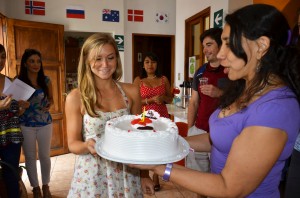 Wednesday, I celebrated my 29th birthday—my first fiesta away from friends and family. It’s a strange feeling to clink glasses in your own honour with people who don’t really know you. It’s light and fun, yet also a tad hallow. But the school was really sweet, bringing me upstairs to the café with the surprise of a cake and candle. Hace un deseo. Make a wish.
Wednesday, I celebrated my 29th birthday—my first fiesta away from friends and family. It’s a strange feeling to clink glasses in your own honour with people who don’t really know you. It’s light and fun, yet also a tad hallow. But the school was really sweet, bringing me upstairs to the café with the surprise of a cake and candle. Hace un deseo. Make a wish.
We went out for dinner at Café Café, at LarcoMar, which is an open-air mall built into the cliffs above the beaches of Lima. Looking out into the ocean, waves shuddering across the rocky shores while we sipped pisco sours and swapped life stories. It felt easy, like I had so much experience venturing out into unknown lands and just seeing what happened, rather than always having a plan. I always have a plan.
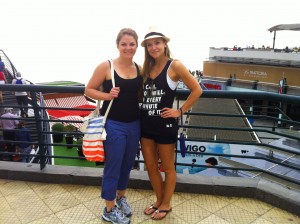
But, the next day, I had anxious sensations creeping through my body. Only two days left. I would be heading home soon, to the snow and cold and drama of the place I call home. I was dreading it, wishing desperately that I could remain behind with the others I had met in Lima—the ones who were lucky enough to still have weeks on end of sand to fill their hourglass.
That night, my last true one in Peru, we headed to Bizaro, a club downtown, to rock out on the dance floor. A mix of American and Latin music filled the speakers, and I was able to forget myself, for a moment, and just give into the carefree few hours.

I was happy to smile and laugh, participating in more of a social vacation than I had known the week before.
But, overall, I think I learned less.
Well, I shouldn’t make such a broad judgment.
I definitely learned less Spanish. Going out with friends for lunch, dinner and dancing, I spoke more English because I wasn’t forced to communicate in the language of the land for more than the four hours of class and the additional basic food ordering.
But the lessons we learn outside of the classroom—both the literal and the metaphoric rooms of intention—the things that dawn on us when we aren’t searching for answers under every rock and relationship, can be the more important clues of life.
Completely exhausted from the night out, I went to my last surf lesson. My instructor asked me to tell him my story, to practice my Spanish. Of my whole life? I asked him. No, he replied. Just about how you got here.
Well, that’s a more complicated journey to relate.
How did I get here? I know that he was referring to the events of my life that led to me choosing Peru, then Lima, that specific school and what I was there to learn. But the inquiry that seemed to be staring me in the face was one of identity.
What parts of your past make up your present? Do you get to choose? Is it like shopping in a massive grocery story where you take the time to pick out the basics that you need, careful to read all the nutritional labels, and then add the spices to make it interesting? Or do items just fly into your cart, threatening to bury you, and it’s only when you’re checking out that you take notice of their presence?
Perched on my surfboard, floating next to my instructor, I thought about all that I had been through over the past year, the past two years. A roller-coaster (on acid) of different lives, where I have seemingly been different people, smashed together into a timeline I have yet to fully digest—that’s the image that came to mind.
But, one of my New Years resolutions is to simplify. Cut the fat and get to the meat of it all.
So, I took it back to the basics for my answer.
Once upon a time, I told him, I fell in love with the Spanish language. The rest that followed was an account of the actions I took—university classes, Spanish class groupons, dreaming of a South American immersion, booking plane tickets, etc. But they were all because of that one moment of magic, the one I can’t really explain away. Not in Spanish. Not even in English.
Isn’t that how all of our stories start? Before embarking on a journey, we fall in love. With something, someone. Whether it’s that person you noticed smiling shyly at you across the room, that introductory class at university that pulled you in a new direction, that first moment she opened her tiny eyes, looking up at you from her newborn blanket, and you saw the bigger picture of the universe laid out before you.
Perhaps it’s too cheesy to say I fell in love with words, but, looking back now, I think I’ve been doing that my whole life. I fell in love with reading before I can remember. Writing came next. Literature. Poetry. Theatre. A foreign language. I have fallen in love many times. Words fill me up with a passion that requires no other response than to chase after their mysterious beauty with a feverish hunger. I will spend all of my life running after them. Gathering more. Rearranging them. Searching for the perfect rhythm. Throwing my hands up in frustration at their shortcomings. Bringing them back with whispered apologies. Holding them close to my heart. Letting them dance free around the page.
On the taxi ride to the airport, I chatted continuously to the driver about my time in Lima, my life back home, my plans for future travels. It was a huge change from my nervous nods and broken sentences that were all I could give to the driver who was eager to speak slowly to me on that first night. I still made mistakes. My Spanish needs a few more weeks (months, years) of work. But, I discovered, I did learn more than a pail full.
But the greater lesson was about taking note of my story. Where I’ve been. What got me here. Why I know where I’m going.
It’s because I’m in love. With words. With creation. With life.
Until my dying day.
Gracias, Perú.
Machu Picchu
What a day.
I set my alarm for 4:20am, because the tour was arranged to pick me up from the hotel at 5:15am. The hotel, Munay Wasi, was nice enough to open the complimentary breakfast bar early for me (i.e. I got to eat toast and drink some orange juice before rushing off). SIDE NOTE: their oranges and orange juice here are 1000% times better than our Florida imported ones–what are we doing wrong?
A 15 minute ride in a van, lead to an hour and a half ride in a bus, then an hour and a half ride in a train and, finally, a twenty minute ride in another bus. I’m no math expert, but that’s a hell of a lot of time spent in transportation. Normally, the train goes straight from Cusco, but in rainy season (now), they create a temporary station in Piscacucho, so it’s half bus, half train.
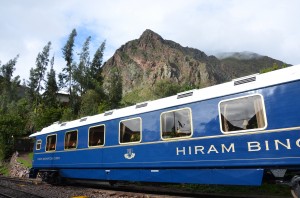
I opted for the vistadome train which has skylights in each car, so you get more of view of the mountains around you. The train follows the Urumbamba river–our guide in Machu Picchu said that in the dry season, it runs clear, but right now it closely resembles the chocolate milk river in the movie Charlie and the Chocolate Factory (you know, the one Augustus Gloop falls into?), except more garbage.
On both trips, there and back, I opted to switch with a passenger who had been assigned a seat away from their other half. The people were grateful and I was indifferent–except then I had to sit across from couples making out (okay, this is an exaggeration… but they did get kissy-kissy). Apparently Machu Picchu is the honeymoon capital of South America. Awesome (insert sarcasm font).
I struggled to stay awake on the bus and train ride, because of the early hour, but I would wake up periodically and assess the new scenery. It was stunning every time I opened my eyes.
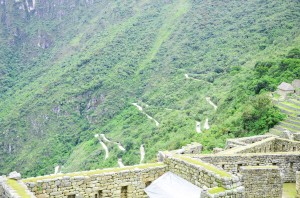
We arrived in the town of Aguas Calientes (where there are famous hot springs) and our guide quickly ushered us through the markets and up to the bus that would zig-zag it’s way to the top. I tried not to look out the window too much, because the bus got perilously close to the edge and I would start to imagine the long plunge downward. However, a British guy in my tour group reminded me that they did this trip hundreds of times per day and probably knew every pot hole out there.
We also chatted about the coca leaves. He had travelled to the Sacred Valley yesterday and the guide gave them fresh leaves to chew (same as the ones I had in my tea) to help with the altitude sickness. Also, if you’ve had coca leaves within three weeks of taking a drug test, you will show positive for cocaine. Good to know.
However, Machu Picchu actually has a lower altitude than Cusco–7,000 feet to Cusco’s 11,000–so there was no need to take anything (but the coca tea is growing on me, and I order it whenever I can–and no, I am not addicted…I can stop at any time…).
You need your passport to enter the site supposedly because otherwise backpackers offer to pay low prices for tickets once people are done for the day, so the government issues only one ticket per person per day.
Despite it being rainy season, we had amazing weather. It was a bit overcast, but pleasantly warm, only spitting a bit of rain (a nice relief, actually) every now and again.
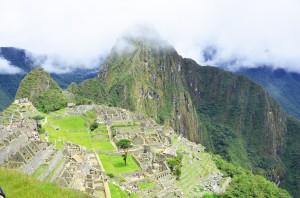
And. Oh. My. Heavens.
Machu Picchu (meaning “Old Mountain” in Quechua) is as beautiful as every guide book describes. Nestled in between impressive rocky mountain peaks, flush with green jungle and an eery fog floating around them, the ancient city has maintained it’s grandeur.
Our guide explained that 70% of what we were seeing was original, from the time of the Incas, and 30% was reconstruction. The site was massive and well laid out, with different living quarters (for specific classes of people, worship, agriculture, irrigation etc.). They were a sophisticated and intelligent people, who were forced to abandon the military city because of the invading Spanish.

They only had it for 100 years before fleeing into the mountains, to avoid being conquered. Because there was no presence of gold or silver in the city, once the Spanish heard that the natives were gone, they felt there was no reason to seize it. Therefore, the city lay dormant for over 400 years, the jungle taking back possession of it and hiding the grand architecture in its green folds.
In the early 1900s, the Peruvians government invited foreign archaeologists from the National Geographic Society to come in and search for these sites, in order to preserve their history (like they saw being done in Egypt). So, in 1911, Hiram Bingham, from Yale University, was led to the site by local farmers, with machetes, who had long known about it’s existence. He then led the excavation of Machu Picchu, carting many of the artifacts away (tsk tsk), but shedding light on the rich history of Peru and the Incas for the rest of the world. Also, the government makes a ton of money off the site every year. Ta da! End of history lesson.
I loved hearing from about the history of the Incas from our guide. His English was pretty good, albeit halting (better than my Spanish, at this point), and he was clearly passionate about the topic. Also, there was lingering bitterness on his tongue toward the Spanish influence on the area; he talked about how important education was to the Incas, as well as the Andean people, but the Spanish deprived them of education opportunities for over 400 years (it was only made public in 1969). Also, the Spanish changed the name of the once-capital city of the Inca Empire from Qusqu (Quechua language, “rock of owl”) to Cusco (Spanish, meaning small dog), because they thought the indigenous people had no souls. So, his attitude has merit.
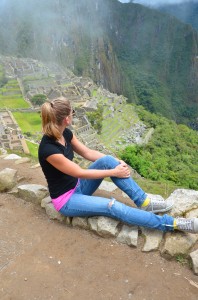 After the two and half tour, the guide gave us a chance to explore on our own before needing to be back at the train station by 3pm. One couple opted to head back down to Aguas Calientes for lunch. Another guy set off for the highest peak to take more pictures. But I couldn’t imagine having travelled all this way and not observing a moment, not doing anything, just taking it all in.
After the two and half tour, the guide gave us a chance to explore on our own before needing to be back at the train station by 3pm. One couple opted to head back down to Aguas Calientes for lunch. Another guy set off for the highest peak to take more pictures. But I couldn’t imagine having travelled all this way and not observing a moment, not doing anything, just taking it all in.
I sat on a ledge for over a half hour, overlooking a thatched roof, breathing in the mountain air and letting the feeling of the ancient city seep into my skin. Time without pictures, without eating, without listening to the myriad of conversations that rose up around me in too many languages to count. I tuned it all out and tried to meditate on the moment.
I can’t tell you the revelations about my own life I received from that time of silence in a sacred place (it would sort of be like revealing a wish after blowing out birthday candles, only more, um, poetic), but I can say it was inspiring. And it was my favourite part of the whole experience because I felt connected, somehow, to a time long ago, but not so different, maybe. I know what it’s like to work hard, build something great and then have to turn around and abandon it for the sake of survival. But survival means the chance to create again. And that possibility drives us forward.
That’s as specific as I’m going to get. The rest I carry away with me, no tacky souvenir needed.
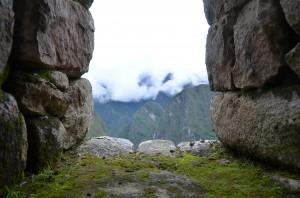
I have to say, if anyone is planning a trip to Cusco and Machu Picchu, take more than two days. You need at least four days in this area to not experience it and feel like you just got whiplash. Travelling for 10 hours to have 3 hours in a park will do that to you. Also, there were so many things that I saw, but didn’t have time to explore properly: the town of Aguas Calientes, the Sacred Valley (more ruins), cooking classes in Cusco (top notch, says la internet).
I guess that just means I will have to come back someday.
(Click on photos to view larger versions; the smaller ones just don’t do it justice)
Mi Primera Dia En Cusco
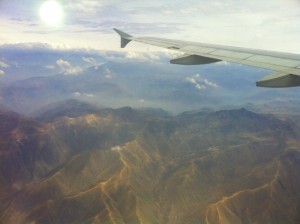
Taking off into the mountains is a beautiful thing to experience. Even though you only get to view it from the tiny window of an airplane, the sight was clearly breathtaking to everyone onboard. Even the kids (we had some screamers).
From a bustling city in Lima, we landed in Cusco just over an hour later. The plane didn’t have far to come down from, as the altitude up here is about 3,400 m (11,200 ft) above sea level. We did one incredible swoop around a mountain in order to land facing the opposite direction. It is a much smaller city (around 300,000) than Lima, but it is by no means small. The buildings, most with matching terracotta roofs, sprawl out over quite a distance.
Stepping onto the tarmac, I expected cooler weather, but was pleasantly greeted with sun. After a short taxi ride to my hotel, I was ready to explore.
A girl in my surf class advised me to take it easy upon first arriving–no running around or jumping up and down–in order to avoid getting altitude sickness. I assured her I would refrain from such actions of celebration.
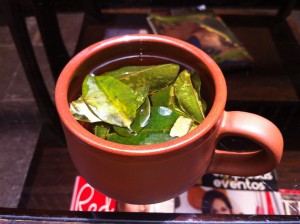
The hotel prepared a cup of coca tea for me to have upon arrival, which tasted a little like grass, but is supposed to prevent sickness. (Click here for more info on coca and it’s link to Cocaine and Coca-Cola.)
However, even just walking around, up some gentle inclines of cobblestone streets, you can start to feel the dizziness creeping up the back of your skull and digging it’s fingers into your brain. A lot of people describe it as very much like a hangover, but I would say it’s quite different. My body feels heavy, my muscles sore and it’s easy to get light-headed when climbing stairs to one of the overwhelming amount of cathedrals (my guide today said there were 18 in the city).
It was raining on and off (so much for the welcome sun), but didn’t seem all that cold, so I just walked the streets and tried to get my bearings.
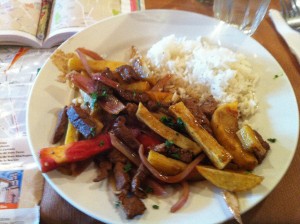
I stopped for lunch near the Plaza de Armas (the main square of the city) and ordered Lomo Saltados (a Peruvian dish common in Cusco, but named after a recreation of seeing the Chinese cooking some sort of stir-fry and tossing the meat from the pan into the air, hence using the verb saltar, to jump, in it’s name). It is sometimes made with beef but usually with alpaca. This I realized after devouring it. So, I’m not sure which I had. Supposedly they taste very similar anyway.
A lot of dizziness disappeared upon filling my stomach, so I mapped out a route in my tour book up to the Inca ruins just outside the city, called Saksaywaman (pronounced like “sexy woman” but it actually means “variable hawk.”)
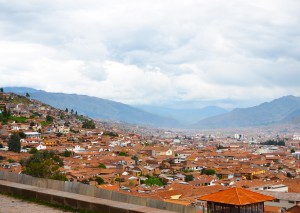
However, on the walk up to the site, it started to rain harder. Water began pouring down the steep street beside me. I got up to another cathedral, about halfway, where Cusco women were trying to get you to pay for a picture with a festively dressed alpaca (something they do in the square as well–which, with an adorable baby one, I might consider shelling out some cash). The view down into Cusco, nestled amongst the mountains, was so beautiful. So, I took a short break but then kept climbing.
And then the hail began. About the size of large-ish Nerd candy. I was mostly covered head to toe with clothing, but any that hit my open hands felt like more than a tickle.
But, I had walked all that way. I wanted the pay off.
And, I got it. For 70 nuevo soles, you can get a ticket into the park, but you really do need a guide, because otherwise it can look like a bunch of randomly placed rocks. So, for another 30, I got Julio. He spoke seven languages, English included, but I asked him to do the tour in Spanish, because I wanted to practice.
At this point, I’m not sure if that was a mistake, because I know that I missed certain details. But, I think it’s good for the brain. And, I’ll have more than enough time with an English guide tomorrow in Machu Picchu.
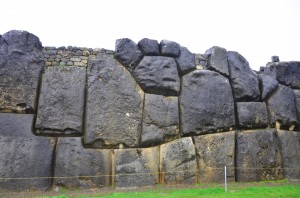 One of the coolest things he talked about (which I understood) was that the Inca people saw their world as being made up of three worlds: below ground, earth and the cosmos. Each was symbolized by an animal. The serpent for beneath, the puma for on top and the condor for above. This number, three, was of huge importance and you can see it’s symbolism in almost everything that’s left behind. Three steps. Three walls. Three levels. And the serpent, puma and condor are often incorporated into the basic structure of the walls that are still standing.
One of the coolest things he talked about (which I understood) was that the Inca people saw their world as being made up of three worlds: below ground, earth and the cosmos. Each was symbolized by an animal. The serpent for beneath, the puma for on top and the condor for above. This number, three, was of huge importance and you can see it’s symbolism in almost everything that’s left behind. Three steps. Three walls. Three levels. And the serpent, puma and condor are often incorporated into the basic structure of the walls that are still standing.
At one point, Julio led me underneath some rock coverings that had what looked like a window carved into them (also in threes), which he said were places for meditation. Then we went in farther. Into the rock. It got to the point where I couldn’t see anything in front or behind me. Tengo miedo (I’m scared), I told him. Es parte de la adverture (It’s part of the adventure), he responded and let me grab his hand while I stumbled through the darkness.
It was indeed terrifying. There was no point in looking behind me, because no light made it into the cave, but I also had no idea how long we were supposed to make our way through what seemed like an oblivion. And that’s probably what made it so scary. Not knowing how long I was to endure the unknown. How long I had to feel scared. It wasn’t really the darkness at all. It was the lack of knowledge. The lack of control.
But the light came back. It always does.
The rain continued throughout the tour and, by the end, I was thoroughly soaked and mildly freezing (my hands were tingling, my thumbs completely numb, my guide book now littered with crimped pages from the rain soaking through my bag).
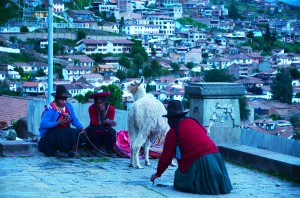
I hadn’t planned on taking an extra tour in Cusco, so I opted out of taking a cab home (dumb, dumb, dumb idea) to save money and thought I could walk it. But ancient rock stairs covered in hours of rain water are even more slippery on the way down (although I did encounter some random alpacas that obliged to have their photos taken for free). Add that to the fact that I got thoroughly lost and walked in circles around the main square, and you have one very frustrated, cold and cranky tourist. Also, the map I was using to find my hotel (a paper one given to me by the hotel upon arrival) was literally disintegrating in my hands as I walked.
I did make it back to my room, running shoes all squishy, but otherwise unharmed. I was very thankful for a hot shower–which felt ice cold for the first while because my extremities were so frigid. Now, only one question remains. How am I going to walk around all day tomorrow in Machu Picchu with sponges for shoes laced to my feet?
Jueves y Viernes: Spanish and Surfing
After an eventful couple of days with New Years and the following day of recuperation, Thursday and Friday of my first week in Lima were days of extreme learning in different fronts.
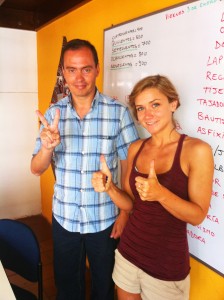
In Spanish class, I played Scrabble and Taboo (en español)–which are way harder when your vocabulary is only a fraction of what you are used to playing with for word games. But, so marks the end of my classes with my teacher, Rene, who is going on vacation next week (I will miss his rapid chatter and constant “ta ta tas” and “cha cha chas”), as well as my accidental private lessons (because it’s a quiet week for the school). We’ve already had two new guests at the house (although I’m fairly confused because both guys seem to be fluent Spanish speakers), and I am told there will be more before class on Monday.
I also embarked on my first surfing lessons (first here in Peru). I had two days of lessons back in 2009 in San Diego, California, but I’m pretty sure I didn’t retain any skills from that experience–only the knowledge that I will not be a quick learner.
Regardless, the nerves set in as soon as I was picked up from the school (on Peruvian time, so over an hour past the scheduled lesson). We travelled in a van with one other student, a British teacher living in Lima, and two instructors, one with limited English and the other with only Spanish. It was the perfect opportunity to practice the language I came here to learn.
If you’ve ever tried to learn a new sport in your adult year, you know that it can be daunting. Now, add the extra element of a foreign language and you have the recipe for potential disaster.
Mind you, the waves (las olas) are gentle along the coast of the city and the instructors patient, so I had a couple of things going for me.
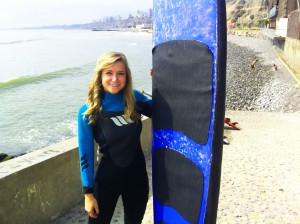
We parked along the side of a busy lot and unloaded quickly. I was given a partially damp wet suit, but hadn’t had a chance to change into my bathing suit prior to arriving. I asked the instructor for a place to change. He pointed to the area around the vehicle. Okay… note to self: arrive already suited up. Luckily, he had a towel with arms for me to borrow, so I could slip on my bikini underneath its folds of fabric, away from the prying eyes of passersby. I struggled into the skin-tight wet suit next and pulled the zipper up with a string. I felt mildly like a spring roll ready to be devoured, but I knew it was better than jumping into the cool ocean without it (they say the water here is too cold for sharks–which is comforting, to a certain degree).
After a somewhat embarrassing warm-up session that involved running, then practicing “popping-up” on a small patch of grass beside the road (Peruvians are not shy with their car horns), we grabbed our boards and heading on down to la playa.
Hardest part, by far: getting out into the ocean. The beach here isn’t sand. It’s small rocks whose sharp points dig into your bare feet, then farther down there are large rocks littered with small crabs that leave you wobbling to and fro, trying to maintain balance–all the while grasping onto a massive surf board.
The water was cool, unlike the Caribbean, but not frigid, unlike back home. We paddled out a distance and then my instructor for the day, Manuel, insisted that I jump off the board and dunk fully into the water to “calm my nerves.” A quiet scream later, I emerged from the water. Estoy lista! (I’m ready!) Uh..I think.
The next two hours were jammed full of halting Spanish (me) and yells of “Levantas!” and “Mas rapido!” (him). I only had one bad fall forward (bad idea) where the board rose over my head and smacked me aggressively on the the noggin, but I managed to get up about seven times, surfing the wave for long enough to start enjoying the ride. Manuel yelled at me to smile while rocking out on the board and to not be so serious. It occurred to me then that I needed to feel more, think less and realize sooner that this was a sport for fun, not just another skill to be mastered step by step (ahh…the North American way). The process of learning the fun of surfing is a great metaphor for learning the fun of life, no?
Before I knew it, Manuel was telling me it was my last wave, and then we headed back to shore (another harrowing adventure to travel back over the perilous rocks).
I came home that night exhausted, but fully satisfied, having put both my mind and body to the test (only my heart remains locked in a cage).
Friday: Wash. Rinse. Repeat.
Tonight, we had a “last night in Lima” dinner for my housemate, Julie, before we both fly to Cusco tomorrow morning (the first stop for her in farther travels around the country, while I will return here on Monday). Right now, it seems like an unknown land of ancient cultures, soft alpacas and fully cooked cuy sandwiches (guinea pig served whole, with the head sticking out between the bread).
I can’t wait.
Estoy lista.
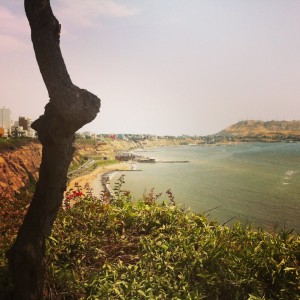
Los Dias 2 y 3
I have only been in Lima for 2 days, but it seems like a lot longer, mostly because there is so much information pouring in at me, all at once, so the days seem very long. In a good way.
I could literally write for pages and pages, but I will try to just highlight a few things, for the sake of your computer-screen-reading eyes.
La ciudad (the city): I was warned by more than a few people that Lima wasn’t a pretty place (some, in fact, called it a “dump”). I have to disagree. It’s a city of more than 10 million people, so yes, there is pollution and traffic and construction–but that’s nothing new to me.
Lima is on the coast of Peru and has a climate very similar to San Diego (in my opinion)–it’s hot, but not Caribbean hot, and has a good breeze coming in off the ocean. Especially close to the water, and more toward the late afternoon, there is a fairly constant fog that hangs in the air. My roommate and I took a taxi down to the beach on Sunday, which is mostly rocks. We discovered, when the day was over, that even though the sun doesn’t feel super-hot because of the fog cover, it can burn you just as nicely.
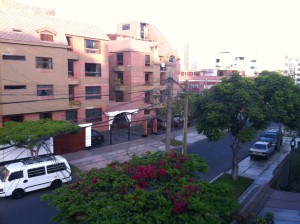
The student house and school are in the Miraflores district, which seems to be very safe. There is a security guard two doors down who patrols the streets, then we have a locked courtyard, front door and individual rooms. It’s a lot of keys to carry.
We walk most places together, but today she wanted to get a manicure after class, so I opted to walk home alone. I took my I-know-where-I’m-going-and-this-is-so-not-a-map-in-hand mask out of my backpack and wore it all the way back to the house. There are many people here with blonde hair, so I am less of an anomaly when I cover up my blue eyes with sunglasses. In cognito, as they say.
I spent the late afternoon in the park near our house, just reading on a bench. There were so many people out enjoying the nice weather: kids playing soccer with their parents, couples on ice cream dates and people walking their dogs. At first, I thought it was strange that there were so many dogs on leashes, and yet also a fair amount of stray dogs clearly trying to sniff out food. I was thinking, “Why would you buy a dog when there are so many just wandering around, needing a good home?” Then it hit me. We have the exact same thing at home, but perhaps less visible (so, way to be prematurely judge-y, Dana). Everyone knows that our humane societies are bursting at the seams with needy animals, and yet we still insist on buying pure bred dogs. The reason for which is unclear. Unless it is all just about control. But, I digress.
I think the city is beautiful. The people are friendly, the buildings are an interesting mish-mash of shapes and colours, and the hustle here is a happy buzz. The people drive quickly, but walk slowly (the latter of which takes some getting used to). Even on vacation, I still feel in a rush.
Los clases (the classes): We arrived at the school at 8am this morning for our initial assessment. Classes are normally set to start at 9am every day, but the first day they want to talk to you and figure out how much you know (i.e. how many times they have to say something in Spanish before the blank look on your face disappears). Right now, there are only four students at the school: the girl from Minnesota who lives with me (Julie), myself (obvi) and two students from the Netherlands, who know zero Spanish.
The four-hour classes are divided into two parts: grammar and conversation. My assessment put me in the second level for grammar, with Julie, and then together with the whole group for conversation. Our first teacher, Rene, started in on past tense verbs right away, making it clear that the entire class would be spoken only in Spanish (he speaks very little English). I expected this, as my second year of Spanish in university was the same way, and I think it’s the best way to learn.
However, Julie had a bit of a freak out and ended up leaving, saying this wasn’t going to work for her. I think she ended up in the other, beginner grammar class, so it was just me, reviewing past tense verb conjugation (imperfecto y indefinito). Sound riveting, I know. But there is something about the pattern of the words that I love, so I thoroughly enjoyed going over the regular and irregular verbs (along with a list of vegetables, for some reason). #bignerdallert
We had a short break after this class, before heading into the next class. Rene informed me, in Spanish, that my vocabulary was at a higher level than the others, so I would find that class too boring (aburrido). So, instead of being with the rest of the group, I now have a day of completely private lessons with him. Score.
We played Uno in the afternoon, with the colour of each card representing something specific we would have to use in a sentence (present tense, different past tenses, vegetables, fruits, etc.). It was a lot of fun and the time went by quickly. It’s surprising how much I understand, even after all these years of being out of classes; even more surprising is how difficult it is to communicate my thoughts. I develop more and more of an appreciation for those in Toronto who are just learning to speak English. Even if you have the words in your head, it’s so exhausting to try and put them in the right order, with correct conjugation and pronunciation, without stumbling multiple times and then relenting to start over at the beginning.
I love every minute of it. I am outside of my comfort zone, yet so enthralled with the beauty of words I am just beginning to understand: it’s both terrifying and exhilarating, all at once. When you get that moment where the words come out in the (somewhat) right order and the sound flows (somewhat) nicely, and you see the light go on in that other person because they realize what you’ve said and start responding… it’s completely empowering. (And then, sometimes they respond with a sentence that makes you realize you did not say what you wanted to say, and it begins again.)
(Note: A lot of English words are similar in Spanish, so when searching for the right one, you can sometimes stumble on the wrong one. The extremely wrong one. For example, someone might be trying to say “I’m so excited!” and come out with “Soy muy excitado!”–but excitado does not mean excited. Well, not in the way you, ahem, perhaps want to exclaim on the street. Unless you are trying to invite sexual advances from passersby. The expression, instead, is “Soy muy emocionado.” So, very important lessons on day one.)
La comida (the food): Oh. My. Food heaven.
We went grocery shopping yesterday, mainly to pick up things for snacks and breakfast at home. But how can you not dine out at every meal when there is such a plethora of delicious spots at every corner?
Strangest thing about the grocery store: I could not find eggs for the longest time. Finally, we gave up and went to check out. Up at the front, we were presented with a rack of eggs next to the cash. Like, where the gum and trashy magazines would be at home. An afterthought. Maybe it’s because they are super-fragile and want to keep an eye on them? No idea. But you have two choices: regular chicken and teeny-tiny quail. I chose regular, but can’t, for the life of me, figure out how the stove works in the house, so it’s mostly a bust. For now.
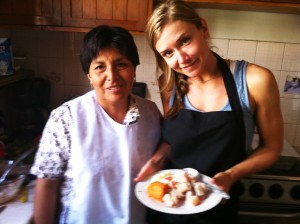
We ate at a gourmet restaurant last night, one recommended in my travel book, called LA 73, in the Barranco district, a short cab ride away. I had homemade spinach ravioli that was so amazing. We also tried the local drink, pisco sour, which is made with lime juice, egg whites, bitters, simple syrup and an alcohol called pisco (duh)–it’s a distilled grape brandy. Not bad.
Following our classes today, we had a welcome lunch of chicken empanadas and then stayed after that for a cooking class, where we made ceviche and more pisco sours.
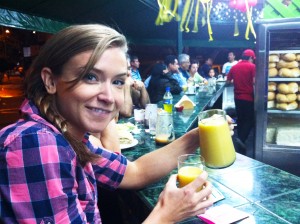
Tonight, we opted for a cheaper meal at an outdoor sandwich bar. For about six dollars, I got a pork sandwich with lots of toppings (called a chicharro–“crackling pork”) and freshly squeezed juice from mysterious fruits that I picked at random. Mango was in the mix there, somewhere.
So, there is a lot of eating.
Not sure how I will be hungry for tomorrow, but somehow, I think I’ll manage.
Day 1: Travel Stories
 I always appreciate friendly folks at the airport. I try to smile and be super-polite as much as possible, because I find even the concept of their jobs very trying.
I always appreciate friendly folks at the airport. I try to smile and be super-polite as much as possible, because I find even the concept of their jobs very trying.
About-to-be-passengers at airports operate, for the most part, with blinders on, completely oblivious to the realities and needs of others around them. The anxiety of imminent travel (i.e. circumstances they cannot control completely, like being eyed as potential criminals at large while going through security and being trapped in a metal tube with strangers for a hours while battling a pea-sized bladder) has them pulled tighter than a Spanish guitar about to break a string. Or two.
I’ve seen people yell at those in uniform behind a desk for weather delays (really?), long line-ups and “unnecessary” security measures—because there is obviously nothing hidden in their Louis Vitton rolly suitcase. They paid big bucks for a trip to Up Tight, Nebraska or Lie on My Butt, Mexico and, by golly, they will be arriving at exactly 12:04, like the ticket promised. Not 12:05. Not 12:14. 12 o’ freaking 4.
Anyway, I have digressed. The individuals who run the airport, yes. They deserve all the niceties you can give them, because you know they will be dealing with nasties throughout the day. The workers usually look tired, worn-down by the day that has only just begun, and I always hope that dealing with someone who remembers manners, all her documents and a simple, but sincere, “How are you?” will ease the tension in the air. Not sure if it works, but hey—still worth the effort.
But every once and awhile, you come across someone at the airport with an attitude of gold.
In my layover destination of Newark, this gentleman at the front of the security area was clearly being overly friendly and conversation to those who passed his gates. Passengers around me were making comments. “Isn’t it nice to run into people like him?” Definitely. I hoped and prayed I wouldn’t be put in the line to my left—which was shorter and moving more quickly—because I knew I was headed for a more than pleasant interaction. I wasn’t disappointed.
“Krook,” he said to me, while checking off the necessary info on my boarding pass. He handed back my documents and seemed to consider me for awhile. “Did you know, that the door man at the White House during President Lincoln’s term had the same last name?”
“For real?” I responded. “Spelled with a K?”
“Yep,” he said, reaching for the next passport in line while still talking to me as I moved slowly ahead. “The President used to say ‘Good night, Krook,’ to him every evening before leaving. The day he was assassinated, Lincoln said ‘Goodbye, Krook,’ instead. Look it up.”
He smiled and wished me a good trip.
Fun facts are everywhere, apparently. I did look it up. And, as I suspected, the very kind gentleman was partially right, but had some facts confused.
Colonel William H. Crook—not Krook—was the President’s bodyguard. The night of the assassination, he was supposed to be relieved by another guard, who didn’t show up. Crook tried to convince the President to let him be a part of the escort to the theatre that evening, but Lincoln waved him off, knowing Crook had already worked all day and they could find someone else to fill in for the night shift. Turns out, that someone else was too negligent and let the shooter, Booth, into the President’s viewing box because he was preoccupied watching the show. Crook was adamant that if he had been allowed to stay on duty, the President would not have died that night (and he might have been right about, seeing as he became a much celebrated bodyguard for 50 years after that, serving 12 Presidents at the White House after Lincoln, none of whom were shot).
Sadly, noble Colonel Crook is not a relative of mine, as his heritage is traced back to England, and my last name, Krook, is actually a recently made-up name that comes from an original in the Ukraine that no one in my family is all too sure about (best guesses are Kroetsch or Kreuk). Language barriers being what they were for new immigrants to Canada in the early 1900s, the whatever-it-was Ukrainian name became the Americanized Krook for future generations to come. Life-altering spelling mistakes. As an English major, it makes my heart hurt.
But, I wonder, what interesting stories will come from language barriers or spelling mistakes on my upcoming adventures?
Sorry to those who wanted an itinerary account of the 13 hour travel day. I have never been one for linear timelines, but I can try to do straightforward reporting.
7-9am: I waited in this crazy Q lounge upon arrival at the airport. They wouldn’t let anyone through customs or security until minutes before their flight, when they would call out departure times. I didn’t get to the customs line until 9:48, when my plane was boarding in 15 minutes. Security, thank goodness, went through without a hitch. And I learned a valuable travel lesson for young females: I always get “randomly” pulled aside for additional security measures when flying solo. BUT, I was behind another single female, who was yanked away, while I was given the clear (it perhaps would look less than random to choose two single females in a row). So, from now on, I will try to position myself behind those of the same demographic.
9-11am: I had to board the puddle-hopper immediately, because by the time I got to the gate—ahead of most on my flight—we were supposed to be leaving in 5 minutes. But I pleasantly slept the whole way, after having a quick conversation with the gentleman sharing my row (he laughed at me for travelling all the way to Peru to learn Spanish, when CLEARLY there were closer options). He was an airplane engineer being called in to fly down to Savannah, Georgia for work on a Saturday and clearly needed to “find the fun.”
11am-2pm: A three-hour layover in Newark. Not much I can say about this one. Except that perhaps fun-less airplane engineer might have been right—Spanish speakers abound in New Jersey.
2-10pm: An eight-hour plane ride after securing a window seat (I neglected to think ahead about my time of arrival—10pm, when it’s dark out—and traded my aisle seat for the you’re-never-getting-up-this-whole-time-even-if-your-bladder-explodes seat). The child behind me screamed and kicked my seat for a good couple of hours, but otherwise nothing extremely noteworthy report. We had to fill out customs forms on the plane and the one form had no English translation at all, so I’m not entirely sure what I signed (kidding! Sort of). But I had no idea what “bultos” meant and the pocket dictionary I was carrying translated it as “lumps,” which I knew couldn’t be right. I left that one blank. (an internet search now reveals that further translations are “piece of luggage”).
10-11:45pm: I counted every victory upon disembarkation: entrance to the country, success at customs, appropriate luggage arrival… When I finally got to ground transportation, it was a scene right out of a movie. Apparently everyone brings THEIR ENTIRE FAMILY to the airport to pick up someone—complete with glittery signs. I imagine that is what celebrities feel like on a red carpet. Except for the fact that I was not dressed in a swanky outfit and heels, but rather airplane-musty clothes and carrying my own heavy luggage. I finally located my driver—with a sign that listed the school name and “Dana Kroop.” He spoke no English, but we managed to have a pretty decent conversation on the 45-minute drive to the student house. Currently, there is only one other girl here, from Minnesota, but there will be more to meet at the school on Monday.
12am-now-ish: Officially ready to crash. Let’s see what the daylight brings to life in Lima tomorrow.

Wow, your write-up is really amazing. I will enjoy following your travels. I have never before come across the YOLO references, so you educated me this evening. Keep well and keep safe.
And a phrase I taught your mother many years ago was “Espero que tu me beses !”